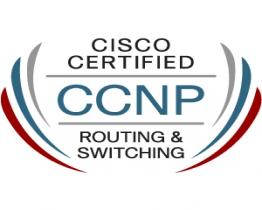
Cisco Certified Network Professional (CCNP®) validates the ability to plan, implement, verify and troubleshoot local and wide-area enterprise networks and work collaboratively with specialists on advanced security, voice, wireless and video solutions. The CCNP certification is appropriate for those with at least one year of networking experience who are ready to advance their skills and work independently on complex network solutions. Those who achieve CCNP have demonstrated the skills required in enterprise roles such as network technician, support engineer, systems engineer or network engineer.
CCNP certification includes three exams.
300-101 Implementing Cisco IP Routing (ROUTE)
300-115 Implementing Cisco IP Switched Networks (SWITCH)
300-135 Troubleshooting and Maintaining Cisco IP Networks (TSHOOT)
300-101 ROUTE
Pre-requisites: CCNA (R&S)
Layer 2 Technologies
1.1 Configure and verify PPP
1.2 Explain Frame Relay (Operations, Point to Point, Multipoint)
Layer 3 Technologies
2.1 Identify, configure, and verify IPv4 addressing and subnetting
2.2 Identify IPv6 addressing and subnetting
- Unicast
- EUI-64
- ND, RS/RA
- Autoconfig (SLAAC)
2.3 Configure and verify static routing
2.4 Configure and verify default routing
2.5 Evaluate routing protocol types
2.6 Describe administrative distance
2.7 Configure and verify VRF lite
2.8 Configure and verify filtering with any protocol
2.9 Configure and verify redistribution between any routing protocols or routing sources
2.10 Configure and verify manual and autosummarization with any routing protocol
2.11 Configure and verify policy-based routing
2.12 Identify suboptimal routing
2.13 Explain ROUTE maps
2.14 Configure and verify loop prevention mechanisms
2.15 Configure and verify RIPv2
2.16 Describe RIPng
2.17 Describe EIGRP packet types
2.18 Configure and verify EIGRP neighbor relationship and authentication
2.19 Configure and verify EIGRP stubs
2.20 Configure and verify EIGRP load balancing
2.21 Describe and optimize EIGRP metrics
2.22 Configure and verify EIGRP for IPv6
2.23 Describe OSPF packet types
2.24 Configure and verify OSPF neighbor relationship and authentication
2.25 Configure and verify network types, area types, and router types
2.26 Configure and verify OSPF path preference
2.27 Configure and verify OSPF operations
2.28 Configure and verify OSPF for IPv6
2.29 Describe, configure, and verify BGP peer relationships and authentication
2.30 Configure and verify eBGP
2.31 Explain BGP attributes and best-path selection
VPN Technologies
3.1 Configure and verify GRE
3.2 Describe DMVPN (single hub)
Infrastructure Security
4.1 Describe IOS AAA using local database
4.2 Describe device security using IOS AAA with TACACS+ and RADIUS
4.3 Configure and verify device access control
Infrastructure Services
5.1 Configure and verify device management
5.2 Configure and verify SNMP
5.3 Configure and verify logging
5.4 Configure and verify Network Time Protocol (NTP)
5.5 Configure and verify IPv4 and IPv6 DHCP
5.6 Configure and verify IPv4 Network Address Translation (NAT)
5.7 Configure and verify IP SLA
5.8 Configure and verify Cisco NetFlow
300-115 SWITCH
Pre-requisites: CCNA (R&S)
Layer 2 Technologies
1.1 Configure and verify switch administration
1.2 Configure and verify Layer 2 protocols
1.3 Configure and verify VLANs
1.4 Configure and verify trunking, VTP
1.5 Configure and verify EtherChannels
1.6 Configure and verify spanning tree
1.7 Configure and verify other LAN switching technologies (SPAN)
1.8 Describe chassis virtualization and aggregation technologies (Stackwise)
Infrastructure Security
2.1 Configure and verify switch security features
- DHCP snooping
- IP Source Guard
- Dynamic ARP inspection
- Port security
- Private VLAN
- Storm control
Infrastructure Services
3.1 Configure and verify first-hop redundancy protocols
- HSRP
- VRRP & GLBP
300-135 TSHOOT
Network Principles
1.1 Use Cisco IOS troubleshooting tools
- Debug
- Ping and trace route
1.2 Apply troubleshooting methodologies
- Diagnose the root cause of networking issues (analyze symptoms, identify and describe root cause)
- Design and implement valid solutions
- Verify and monitor resolution
Layer 2 Technologies
2.1 Troubleshoot Layer 2 protocols
2.2 Troubleshoot VLANs
2.3 Troubleshoot trunking, VTP
2.4 Troubleshoot EtherChannels
2.5 Troubleshoot spanning tree
Layer 3 Technologies
3.1 Troubleshoot IPv4 addressing and subnetting
3.2 Troubleshoot IPv6 addressing and subnetting
3.3 Troubleshoot static routing
3.4 Troubleshoot default routing
3.5 Troubleshoot administrative distance
3.6 Troubleshoot RIP, EIGRP, OSPF, BGP
VPN Technologies
4.1 Troubleshoot GRE
Infrastructure Security
5.1 Troubleshoot IOS AAA using local database
5.2 Troubleshoot device access control
5.3 Troubleshoot router security features
Infrastructure Services
6.1 Troubleshoot device management
6.2 Troubleshoot SNMP
6.3 Troubleshoot logging
6.4 Troubleshoot Network Time Protocol(NTP)
6.5 Troubleshoot IPv4 and IPv6 DHCP
6.6 Troubleshoot IPv4 Network Address Translation (NAT)
6.7 Troubleshoot SLA architecture

